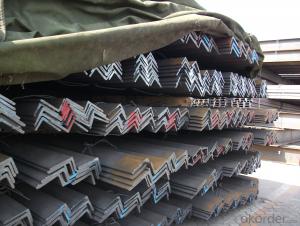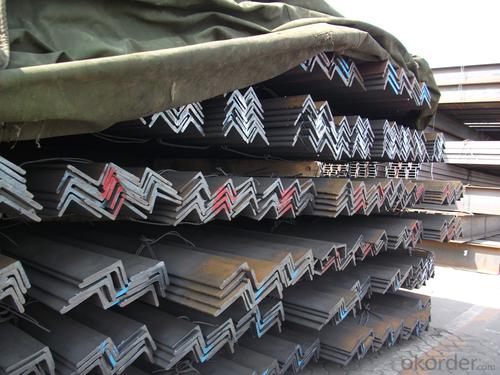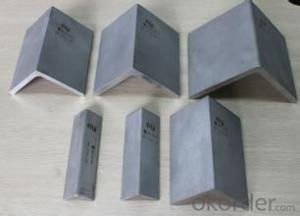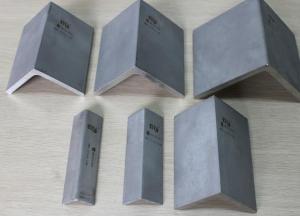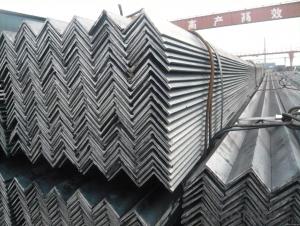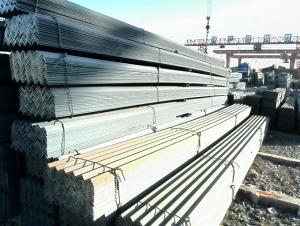JIS Unequal Steel Angle
OKorder Service Pledge
OKorder Financial Service
You Might Also Like
Specifications of Unequal Angle Steel:
1.Standards: JIS
2.Length: 6m,9m,12m
3.Material: SS400 or Equivalent
4. Size:
Size (mm) | Mass (mm) | Size (mm) | Mass (mm) |
| 75*50*5.0 | 4.8 | 75*50*8.0 | 7.43 |
| 75*50*6.0 | 5.66 | 100*75*6.0 | 8.04 |
Packaging & Delivery of Unequal Angle Steel
1. Transportation: the goods are delivered by truck from mill to loading port, the maximum quantity can be loaded is around 40MTs by each truck. If the order quantity cannot reach the full truck loaded, the transportation cost per ton will be little higher than full load.
2. With bundles and load in 20 feet/40 feet container, or by bulk cargo, also we could do as customer's request.
3. Marks:
Color mark: There will be color marking on both end of the bundle for the cargo delivered by bulk vessel. That makes it easily to distinguish at the destination port.
Tag mark: There will be tag mark tied up on the bundles. The information usually including supplier logo and name, product name, made in China, shipping marks and other information request by the customer.
If loading by container the marking is not needed, but we will prepare it as customer request.
*If you would like to get our price, please inform us the size, standard/material and quantity. Thank you very much for your attention.
- Q: What are the different types of steel angles available?
- There exists a variety of steel angles available, each specifically designed for particular applications and purposes. Examples of these include: 1. Equal Angle: These steel angles, also referred to as L-shaped angles, possess equal side lengths and are commonly utilized for general structural and construction purposes. They offer exceptional support and stability when interconnected with other structural components. 2. Unequal Angle: As the name implies, unequal angles feature different side lengths. These angles are frequently employed in applications where one side needs to be longer or shorter than the other, such as supporting uneven loads or creating specific shapes. 3. Stainless Steel Angle: Constructed from stainless steel, these angles exhibit high resistance to corrosion, making them suitable for applications where exposure to moisture or chemicals is a concern. They find common usage in food processing plants, chemical industries, and marine environments. 4. Galvanized Angle: Galvanized steel angles are coated with a layer of zinc, thereby providing excellent corrosion resistance. This makes them ideal for outdoor applications or areas exposed to high humidity or saltwater. 5. Rolled Steel Angle: Rolled steel angles are produced by rolling hot-rolled steel into the desired shape. This process enhances the angle's strength and durability, rendering it suitable for heavy-duty applications. 6. Slotted Angle: Slotted angles feature holes or slots along their length, facilitating easy attachment and adjustment. They are commonly utilized in shelving systems, workbenches, and storage racks, as they offer a versatile and customizable solution. 7. Structural Steel Angle: These angles are mainly deployed in construction projects requiring load-bearing support. They are designed to withstand heavy loads and provide structural stability in buildings, bridges, and other infrastructure projects. It is crucial to assess the specific requirements of your project before selecting the appropriate type of steel angle. Seeking guidance from a structural engineer or steel supplier can ensure that you choose the correct angle for your application.
- Q: How do steel angles compare to other structural shapes?
- Steel angles are a versatile and commonly used structural shape in construction and engineering. They have several advantages over other structural shapes, such as beams or channels. Firstly, steel angles offer excellent strength and stability. Their L-shaped design provides rigidity and support, making them ideal for load-bearing applications. They can effectively resist both compressive and tensile forces, making them suitable for a wide range of structural applications. Secondly, steel angles have a compact and space-saving profile. Unlike other structural shapes like beams or channels, angles have a smaller cross-sectional area, making them more efficient in terms of material usage. This can result in cost savings and reduced weight in construction projects. Moreover, steel angles are highly adaptable and can be easily customized to fit specific project requirements. They can be cut, welded, drilled, and modified without compromising their structural integrity. This flexibility allows for easy integration into various structural systems and applications. Additionally, steel angles offer versatility in terms of their connection options. They can be bolted, welded, or riveted, providing flexibility in joining them with other structural components. This makes them suitable for a wide range of building and construction projects. Finally, steel angles are readily available and cost-effective. They are widely produced and stocked by steel manufacturers, making them easily accessible. Their affordability, combined with their durability and strength, makes them a popular choice for structural applications. In summary, steel angles compare favorably to other structural shapes due to their strength, space-saving design, adaptability, connection options, and cost-effectiveness. Their versatility and performance make them a preferred choice in various construction and engineering projects.
- Q: What are the different types of steel angles used in engineering?
- There are several types of steel angles commonly used in engineering applications, including equal angles, unequal angles, L-shaped angles, and T-shaped angles. Each type has its own unique properties and uses, with equal angles being suitable for general structural purposes, unequal angles used for supporting various loads, L-shaped angles for framing and bracing, and T-shaped angles for connecting and supporting components.
- Q: How do you determine the required angle thickness for a specific application?
- To determine the required angle thickness for a specific application, several factors need to be considered. These include the load and weight it needs to support, the material properties, the application's safety requirements, and any applicable building codes or regulations. Additionally, factors like the angle's length and shape, the type of fasteners used, and potential environmental conditions should also be taken into account. Consulting engineering guidelines, conducting structural calculations, and seeking professional advice can help in determining the appropriate angle thickness for a specific application.
- Q: How do steel angles perform in extreme weather conditions?
- Steel angles are highly durable and resistant to extreme weather conditions. They can withstand high winds, heavy rains, and temperature fluctuations without losing their structural integrity. Their strength and stability make them an excellent choice for construction projects in areas prone to hurricanes, tornadoes, or harsh climates.
- Q: What are the different design considerations for steel angles in architectural applications?
- When incorporating steel angles into architectural applications, there are various factors to consider. These factors encompass load-bearing capacity, structural integrity, aesthetics, design flexibility, and corrosion resistance. Load-bearing capacity is a primary concern when using steel angles in architectural applications. They are often employed for structural support purposes, so it is essential to ensure they can withstand the anticipated loads. This necessitates calculating the maximum load they will bear and selecting angles of appropriate size and thickness to handle these loads safely. Structural integrity is another crucial consideration. Architects and engineers must take into account factors such as the angles' resistance to bending, buckling, and shear. The design must also consider their ability to distribute loads evenly, minimizing the risk of failure or deformation. Aesthetics also hold significant importance in architectural design, and steel angles can contribute to the overall visual appeal of a building. By incorporating angles with different profiles, finishes, or decorative elements, architects can enhance the design and create visually appealing structures. It is crucial for the angles to complement the overall architectural style and seamlessly blend with other building materials. Design flexibility is another vital consideration. Architects often require angles that can be easily customized or fabricated to meet their specific design requirements. Steel angles offer the ability to be cut, welded, or bent, allowing for the creation of unique shapes and angles and enabling creative architectural solutions. Lastly, it is important to evaluate the material properties and corrosion resistance of the steel angles. Architects need to assess the environmental conditions of the project site and choose angles that can withstand exposure to moisture, chemicals, or other corrosive agents. Applying proper coatings or treatments can protect the angles from corrosion and ensure their longevity. In conclusion, the design considerations for steel angles in architectural applications include load-bearing capacity, structural integrity, aesthetics, design flexibility, and corrosion resistance. By carefully examining these factors, architects can select steel angles that fulfill both the functional and visual requirements of their projects, resulting in safe, durable, and visually appealing architectural structures.
- Q: Can steel angles be used for manufacturing decorative brackets?
- Certainly! Decorative brackets can be manufactured using steel angles. These angles possess great versatility, allowing for effortless fabrication into a variety of shapes and sizes, thus making them ideal for the creation of decorative brackets. By cutting, welding, and forming the angles into diverse designs, one can achieve the desired aesthetic appeal. Moreover, steel angles offer exceptional strength and durability, guaranteeing the ability to support the weight of the objects they hold. Whether it be for architectural purposes or home décor, steel angles provide a dependable and economically viable choice for the production of decorative brackets.
- Q: Can steel angles be used for framing windows or doors?
- Yes, steel angles can be used for framing windows or doors. They provide structural support and stability, making them a suitable choice for framing openings in buildings.
- Q: Can steel angles be used for reinforcement bars?
- Steel angles cannot be used as reinforcement bars. Despite being made of steel, they possess different structural properties and serve different purposes. Reinforcement bars, or rebar, are specially designed to enhance the tensile strength and reinforcement of concrete structures. They have a ribbed or deformed surface that facilitates better bonding with the concrete. Conversely, steel angles are L-shaped structural components primarily employed for support and stability in construction endeavors. They are unsuitable for providing the necessary tensile strength and bonding required for concrete reinforcement. Hence, it is imperative to use the appropriate materials for their intended purposes to ensure the construction project's structural integrity and safety.
- Q: Are steel angles suitable for load-bearing walls in residential buildings?
- Load-bearing walls in residential buildings can indeed be supported by steel angles. The reason for their widespread use in construction is their impressive strength and durability. These angles are capable of withstanding heavy loads and contribute to the stability of the structure. Moreover, steel angles offer the advantage of easy installation and cost-effectiveness compared to alternative building materials. Additionally, they possess fire-resistant properties, a crucial aspect for ensuring the safety of residential buildings. In conclusion, steel angles are a dependable option when it comes to load-bearing walls in residential buildings.
Send your message to us
JIS Unequal Steel Angle
OKorder Service Pledge
OKorder Financial Service
Similar products
Hot products
Hot Searches
Related keywords
